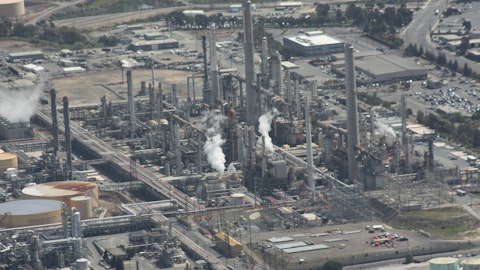David Silver: Yes hi, good morning. I was going to ask you a question, I guess, about the shortfalls, I guess, on the catalyst side, in particular. So I know you’ve kind of come at this a couple of different ways. Maybe I just would benefit from one more time through. But as far as nylon goes, I mean, I’m pretty comfortable with the idea that the softness in China is definitely leading to some export — opportunistic exporting out of there. And given the size of the global market, that makes sense to me. But I always think of the polyethylene market, in particular, as a much bigger market and much less cyclical, more tied to consumer nondurables and very global. So could you just talk about like the magnitude, I guess, of the disruption here that would lead to the size or the magnitude of the impact on your results?
In other words, is it just the garden variety recession is doing this? Or is it something that’s much more targeted and, I don’t know, multistep or whatever where people are not just reducing current operating rates, but destocking at the same time. Just trying to get comfortable with in such a large, relatively noncyclical end market, such as polyethylene, why the severity of the drop off seemingly over a relatively compressed period of time. Thank you.
Kurt Bitting: Yes. Thanks for the question, David. So I think I’ll put it in — maybe I’ll try to break it down a little bit further. I mean we’re really seeing in polyethylene, particularly the regions that are slower are in Asia and Europe, right, where Asia obviously linked to the slower recovery in China or lack thereof maybe is a better way to put it. And then Europe, rates of — operating rates have been turned down. Obviously, in conjunction with the slowness of the macroeconomic activity, but also their cost competitive — cost competitiveness as well. Fortunately for us that tends to be — that’s I mean, minority share of where we ship our products. But I would say that some of that distortion particularly maybe in Asia, as you spoke with nylon as the lack of Chinese recovery creates opportunistic exports elsewhere in the world.
Some of that may be going on in polyethylene as well. So that’s leading to maybe some lower operating rates elsewhere in the world as well as some destocking.
David Silver: Okay. Thank you for that. I appreciate it. I’d like to switch over to maybe the renewable fuels catalyst area and SAF. And in particular, I was wondering if you could talk through a little bit of how the selling process kind of works in practice. So in other words, a lot of catalysts — I don’t want to say they’re off the shelf, but they are well understood and the feedstock that they work with is mature and well developed. And I’m contrasting that with renewable fuels, at least from a global perspective where there could be a very wide range of feedstocks. And different people have much different capacity needs from time to time. So could you just talk about how you make — how you plan to make your inroads in that market?
Is it really customer to customer? Is there some uniformity or uniform standards for the products that are emerging? And then regarding SAF in particular, I mean, obviously, that’s a very nice opportunity let’s say, over the medium term. But what final milestones really, in your opinion, need to be met or across for that product to really start to be used in volume. In other words, are all the regulatory approvals in place? Are there certain other issues that you would cite that or maybe the final stumbling block to unlocking a fair amount of demand in that end-market? Thank you.
Kurt Bitting: Sure. Well, maybe I’ll work backwards from that, David. So I think really from a milestone point for SAF, I mean, what we sort of look forward to is again, that regulatory approvals for the fuels and that an eventual commitments by the airlines of blending in certain percentages, right, of the sustainable aviation fuel. Most of the airlines have come forth with goals, various goals in terms of what they want to blend in their fuel pools going forward. I think that obviously, again, will depend on the regulatory approvals and then followed by the availability of the fuels themselves. So we think long-term, we’re excited about that market. In terms of selling into renewable fuels and sustainable aviation fuel, there’s — the good news is with our business, we’ve got a lot of experience working with customers, our ability to really tailor catalysts and work with them on their various different feedstocks.
So of course, you know renewable fuels is largely linked to fats and oils and such. There’s some of that for sustainable aviation, but we’re also — we also work with others that are looking at taking shorter carbon chains, right, and putting them together to make aviation fuels. So things like ethanol to aviation fuel. And the good news is our DLI technology really can act as a catalyst for both ways, right? So we work with our customers based on what their individual technology is, and we’ve got a really good, obviously set up here in our Conshohocken site that allows us to quickly pilot those catalysts and work with those customers so they can obviously test their units out and try to produce fuels to get tested with the airlines.
David Silver: Okay, thank you very much. Appreciate it.
Operator: We have no further questions in the queue at this time. This does conclude the Ecovyst Second Quarter 2023 Earnings Call and Webcast. Thank you for your participation and you may disconnect at any time.
Follow Ecovyst Inc. (NYSE:ECVT)
Follow Ecovyst Inc. (NYSE:ECVT)
Receive real-time insider trading and news alerts


